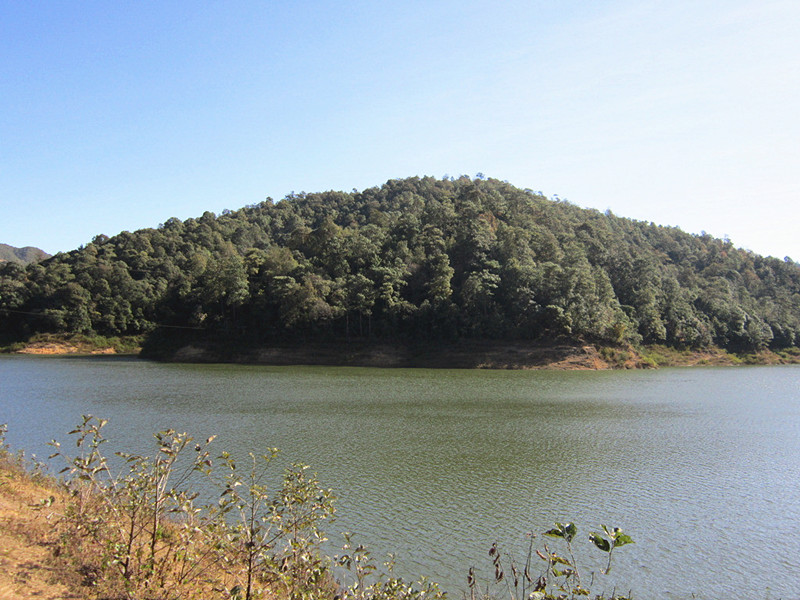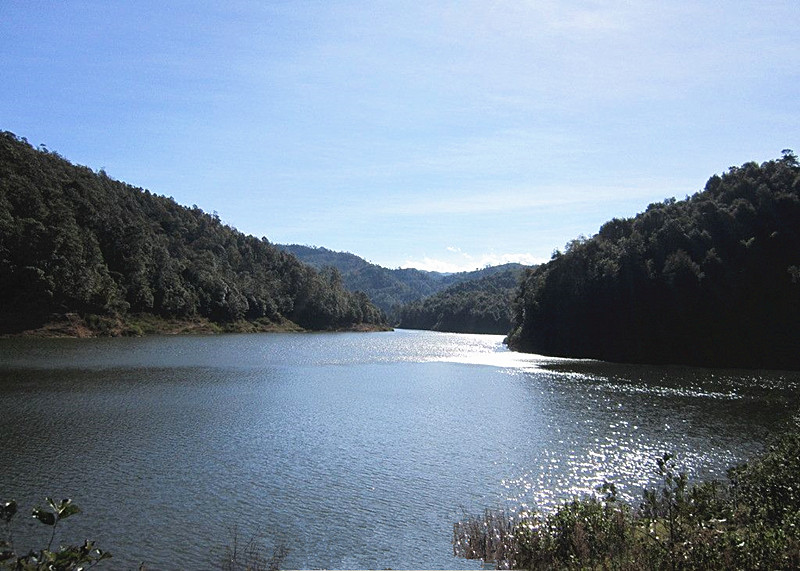 alt="Puer Surrounding Counties and Towns: Weekly & Special Local Markets Travel Guide"
/>
alt="Puer Surrounding Counties and Towns: Weekly & Special Local Markets Travel Guide"
/>
Zhimahu Lake Forest Park in Kaiyuan City, Honghe
Overview
Zhimahu Lake Forest Park (灵芝湖森林公园), originally known as the Maza Shao Yuanzhong Reservoir (马者哨远近冲水库), was established in the late 1950s. It has a storage capacity of 4.6 million cubic meters and covers a water surface area of 1,000 acres. The park is located over 30 kilometers from the city center, encompassing more than 6,000 acres with a forest coverage rate of 67% and an elevation of 2,100 meters. The annual rainfall reaches 1,200 millimeters, and the air is rich in oxygen ions, with levels 30% higher than those in urban areas, earning it the title of “natural oxygen bar.” The forest is home to clusters of camellias (山茶) and rhododendrons (杜鹃), with over 150 trees aged over a century.
The area is populated by the Han (汉), Yi (彝), and Miao (苗) ethnic groups. It features remnants of ancient religious customs described by historians as “living fossils” of Yi culture, along with lively and grand ethnic celebrations such as the “Dragon Festival” (祭龙节) and the “Torch Festival” (火把节).
Geographic Environment
Zhimahu Lake Forest Park (灵芝湖森林公园), originally known as Maza Shao Yuanzhong Reservoir (马者哨远近冲水库), was established in the late 1950s. It has a storage capacity of 4.6 million cubic meters and covers a water surface area of 1,000 acres. The park is located over 30 kilometers from the city center, encompassing more than 6,000 acres with a forest coverage rate of 67% and an elevation of 2,100 meters. The annual rainfall reaches 1,200 millimeters, and the air is rich in oxygen ions, with levels 30% higher than those in urban areas, earning it the title of “natural oxygen bar.”
Natural Resources
The forest naturally harbors clusters of camellias (山茶) and rhododendrons (杜鹃), with over 150 trees aged over a hundred years.
Main Attractions
- First Attraction: Yi Family Village (彝家山寨)
According to historical records, Yi Family Village (彝家山寨) is a small mountain village with only 27 households, named Luoshidi (倮施底). It is inhabited by hardworking and kind Yi villagers who have a deep affection for dragons. During the spring plowing season, these villagers perform dragon worship rituals to pray for favorable weather and national peace. - Second Attraction: Hundred-Year Rhododendron Mountain (百年杜鹃山)
Rhododendron is one of the eight famous flowers of Yunnan (云南八大名花), which include camellia (山茶花), rhododendron (杜鹃花), magnolia (玉兰花), primrose (报春花), lily (百合花), orchid (兰花), gentian (龙胆花), and green gentian (绿绒蒿). Globally, there are over 850 species of rhododendron, with more than 650 found in China and over 400 in Yunnan alone, making Yunnan the geographical distribution center for rhododendrons. When in bloom, the flowers create a spectacular “sea of flowers” stretching over 10 kilometers. The flower’s vibrant shapes and colors have led to it being praised by the poet Su Shi (苏轼) as “This flower resembles Xi Shi among flowers. Hibiscus and peonies are like mere maidens.” Thus, rhododendrons are known as the “Xi Shi among flowers” (花中西施).
Additionally, there are numerous naturally formed camellias in the forest, which are considered the premier flower among the eight famous flowers of Yunnan. Worldwide, there are over 80 species of camellias, with 35 species found in Yunnan, accounting for 44% of the total. The camellia in Yunnan is an evergreen tree that can reach over ten meters in height, flowering from December to April of the following year, with different varieties blooming successively. Yunnan has a long history of cultivating camellias, with records indicating cultivation began as early as the Sui (隋) and Tang (唐) dynasties. During the Nanzhao (南诏) and Dali (大理) periods (8th to 13th centuries), they became important ornamental plants. For centuries, camellias have been intertwined with the lives of the people of Yunnan, known for their stunning beauty and vibrant colors, enjoying a great reputation both domestically and internationally.
Ethnic Culture
Surrounding the park are the Han (汉), Yi (彝), and Miao (苗) ethnic groups. This area features remnants of ancient religious customs described by historians as “living fossils” of Yi culture, along with vibrant and grand ethnic celebrations such as the “Dragon Festival” (祭龙节) and the “Torch Festival” (火把节).
How to Get There
To reach Zhimahu Lake Forest Park, you can take a local bus or drive from Kaiyuan City (开远市). The journey typically takes around 30 to 40 minutes.
Travel Tips
- Best Time to Visit: Spring and early summer are ideal for enjoying the blooming flowers and mild weather.
- Local Guides: Consider hiring a local guide to learn more about the rich cultural heritage and natural beauty of the area.
- Respect Local Customs: Be mindful of the traditions and customs of the local ethnic communities.
- Pack Essentials: Bring water, snacks, and sunscreen, especially if you plan to hike or explore the area extensively.



 7 Days GolfingTour
7 Days GolfingTour
 8 Days Group Tour
8 Days Group Tour
 8 Days Yunnan Tour
8 Days Yunnan Tour
 7 Days Shangri La Hiking
7 Days Shangri La Hiking
 11 Days Yunnan Tour
11 Days Yunnan Tour
 6 Days Yuanyang Terraces
6 Days Yuanyang Terraces
 11 Days Yunnan Tour
11 Days Yunnan Tour
 8 Days South Yunnan
8 Days South Yunnan
 7 Days Tea Tour
7 Days Tea Tour
 8 Days Muslim Tour
8 Days Muslim Tour
 12 Days Self-Driving
12 Days Self-Driving
 4 Days Haba Climbing
4 Days Haba Climbing
 Tiger Leaping Gorge
Tiger Leaping Gorge
 Stone Forest
Stone Forest
 Yunnan-Tibet
Yunnan-Tibet
 Hani Rice Terraces
Hani Rice Terraces
 Kunming
Kunming
 Lijiang
Lijiang
 Shangri-la
Shangri-la
 Dali
Dali
 XishuangBanna
XishuangBanna
 Honghe
Honghe
 Kunming
Kunming
 Lijiang
Lijiang
 Shangri-la
Shangri-la
 Yuanyang Rice Terraces
Yuanyang Rice Terraces
 Nujiang
Nujiang
 XishuangBanna
XishuangBanna
 Spring City Golf
Spring City Golf
 Snow Mountain Golf
Snow Mountain Golf
 Stone Mountain Golf
Stone Mountain Golf














 What Our Customers Say?
What Our Customers Say?
